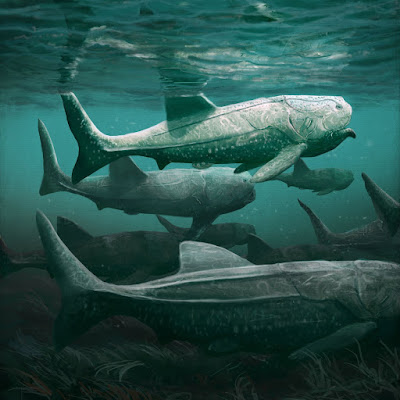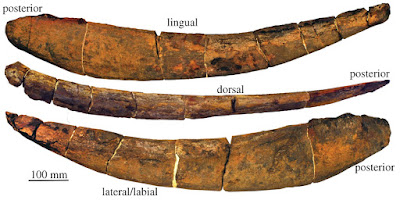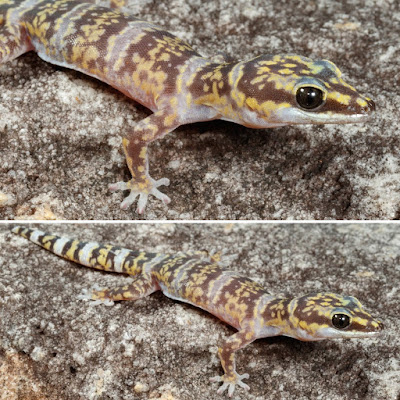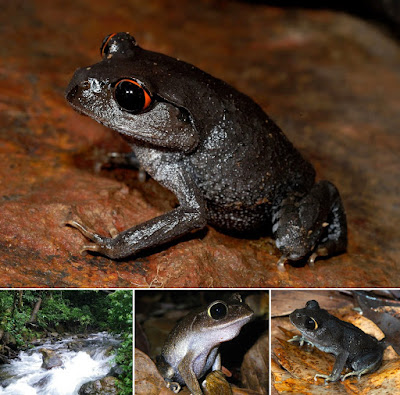[Most Recent Entries] [Calendar View]
Thursday, May 21st, 2020
| Time | Event | ||||||
| 2:06a | [PaleoIchthyology • 2020] Was the Devonian Placoderm Titanichthys A Suspension Feeder?
Abstract Large nektonic suspension feeders have evolved multiple times. The apparent trend among apex predators for some evolving into feeding on small zooplankton is of interest for understanding the associated shifts in anatomy and behaviour, while the spatial and temporal distribution gives clues to an inherent relationship with ocean primary productivity and how past and future perturbations to these may impact on the different tiers of the food web. The evolution of large nektonic suspension feeders—‘gentle giants’—occurred four times among chondrichthyan fishes (e.g. whale sharks, basking sharks and manta rays), as well as in baleen whales (mysticetes), the Mesozoic pachycormid fishes and at least twice in radiodontan stem group arthropods (Anomalocaridids) during the Cambrian explosion. The Late Devonian placoderm Titanichthys has tentatively been considered to have been a megaplanktivore, primarily due to its gigantic size and narrow, edentulous jaws while no suspension-feeding apparatus have ever been reported. Here, the potential for microphagy and other feeding behaviours in Titanichthys is assessed via a comparative study of jaw mechanics in Titanichthys and other placoderms with presumably differing feeding habits (macrophagy and durophagy). Finite-element models of the lower jaws of Titanichthys termieri in comparison to Dunkleosteus terrelli and Tafilalichthys lavocati reveal considerably less resistance to von Mises stress in this taxon. Comparisons with a selection of large-bodied extant taxa of similar ecological diversity reveal similar disparities in jaw stress resistance. Our results, therefore, conform to the hypothesis that Titanichthys was a suspension feeder with jaws ill-suited for biting and crushing but well suited for gaping ram feeding. Keywords: suspension feeding, Devonian, Arthrodira, Titanichthys, comparative biomechanics Conclusion: FEA of the lower jaw of Titanichthys revealed that it was significantly less resistant to von Mises stress than those of related arthrodires that used macrophagous feeding strategies. This suggests that these strategies would not have been viable for Titanichthys, as its jaw would have been insufficiently mechanically robust. Consequently, it is highly likely that Titanichthys was a suspension feeder—a feeding method that is likely to exert considerably less stress on the jaw than macrophagous feeding modes. The validity of assigning suspension feeding based on jaw mechanical resilience is supported by the roughly equivalent patterns known from lineages containing extant suspension feeders. Common morphological trends in the convergent evolution of megaplanktivores can not only be observed but quantified mechanically using FEA. A variety of methods were used to compare between the jaw models, due to imperfections with solely comparing visually or using average stress. The intervals method grouped feeding strategies to an extent, providing an additional perspective. Tafilalichthys, probably a member of the Mylostomatidae and, therefore, one of Titanichthys' closest relatives, appears to have been durophagous. Durophagy is the likely feeding mode of all crown-group mylostomatids except Titanichthys, suggesting that it evolved from a durophagous ancestor. This durophage-to-planktivore transition is surprisingly common among convergently evolved giant suspension feeders: it is also seen in multiple, independently evolved planktivorous elasmobranch lineages. The presence of a megaplanktivore in the Famennian supports the theory that productivity was high in the Late Devonian, which was probably a result of increased eutrophication caused by the diversification of terrestrial tracheophytes and the advent of arborescence. It reflects the link between the increasing complexity of Devonian marine ecosystems and the functional diversity of Arthrodira, which occupied a wide range of ecological niches. Most significantly, it reveals that vertebrate megaplanktivores probably existed over 150 Ma prior to the Mesozoic pachycormids, previously considered the earliest definitive giant suspension feeders. Samuel J. Coatham, Jakob Vinther, Emily J. Rayfield and Christian Klug. 2020. Was the Devonian Placoderm Titanichthys A Suspension Feeder? Royal Society Open Science. DOI: 10.1098/rsos.200272 Ancient giant armored fish fed in a similar way to basking sharks | ||||||
| 2:22a | [Entomology • 2020] Sinoperlodes zhouchangfai • A New Genus of Subfamily Perlodinae (Plecoptera, Perlodidae) from coastal southeastern China Abstract Sinoperlodes zhouchangfai gen. nov., sp. nov. is described and illustrated on the basis of male and female adults from Tianmu Mountain, Zhejiang Province of southeastern China, representing the first record of subfamily Perlodinae in coastal southeastern China. The new genus is characterized by extremely complicated netlike venation on apical half of wings; an entire, moderately elevated tergum 10 of male which with small transverse membrane and posteriorly covered with sensilla basiconica and sharp spines; seven small apical lobes of aedeagus; short elliptical eversible paraproct lobes and banded legs. Female of the new genus is distinctive with an elongated, broad subgenital plate covering sternum 9. Keywords: Plecoptera, Perlodidae, Perlodinae, Sinoperlodes zhouchangfai gen. nov., sp. nov., southeastern China  Zhi-Teng Chen. 2020. Sinoperlodes, A New Genus of Subfamily Perlodinae (Plecoptera, Perlodidae) from coastal southeastern China. Zootaxa. 4779(4); 584–594. DOI: 10.11646/zootaxa.4779.4.9 | ||||||
| 4:45a | [PaleoEntomology • 2020] Morrisonnepa jurassica • First Fossil True Water Bugs (Heteroptera, Nepomorpha) from Upper Jurassic strata of North America (Morrison Formation, southeastern Utah)
ABSTRACT The first fossil hemipteran from the Late Jurassic of North America, Morrisonnepa jurassica n. gen. et n. sp., is reported and described from the Morrison Formation, Jurassic Salad Bar locality, San Juan County, Utah, USA. The new specimen is characterised and illustrated, showing morphological characters similar to nepomorphs such as forewing well-developed and folded flat on the abdomen, oval abdomen shape, and the presence of a short pair of appendages. The taxonomic allocation close to members of the Nepomorpha is discussed. Morrisonnepa jurassica n. gen. et n. sp. was collected with abundant plants, spinicaudatan carapaces, and a small amphibian from a finely laminated shale that overlies a coarser plant debris bed, supporting the presence of a possible oxbow lake or pond, environments developed within the greater ecosystem of the Morrison Formation during the Late Jurassic. In this context, we analyse the taphonomic and palaeoecological implications of the presence of aquatic insects. Besides providing morphological information on Jurassic nepomorphs, the new fossil helps illustrate how the aquatic insect assemblage was integrated during the Jurassic in North America. KEYWORDS: Heteroptera, Nepomorpha, Late Jurassic, Morrison Formation, North America (Utah) Systematic palaeontology Order: HEMIPTERA Linneaus (1758) Suborder: HETEROPTERA Latreille (1810) Infraorder: NEPOMORPHA Popov (1968) Family: Incertae Sedis Genus: Morrisonnepa Lara, Foster, Kirkland, and Howells, n. gen. Derivation of name: The generic name derives from the Morrison Formation, and –nepa, a standard suffix used for the superfamily Nepoidea. Morrisonnepa jurassica Lara, Foster, Kirkland, and Howells, n. sp. Derivation of name: The specific name jurassica refers to Jurassic Period from which the species is derived. María B. Lara, John R. Foster, James I. Kirkland and Thomas F. Howells. 2020. First Fossil True Water Bugs (Heteroptera, Nepomorpha) from Upper Jurassic strata of North America (Morrison Formation, southeastern Utah). Historical Biology: An International Journal of Paleobiology. DOI: 10.1080/08912963.2020.1755283 | ||||||
| 6:03a | [Herpetology • 2020] Oedura nesos • A New Velvet Gecko (Oedura: Diplodactylidae) from Groote Eylandt, Northern Territory, Australia
Abstract Over the last decade, the combination of biological surveys, genetic diversity assessments and systematic research has revealed a growing number of previously unrecognised vertebrate species endemic to the Australian Monsoonal Tropics. Here we describe a new species of saxicoline velvet gecko in the Oedura marmorata complex from Groote Eylandt, a large island off the eastern edge of the Top End region of the Northern Territory. Oedura nesos sp. nov. differs from all congeners in combination of moderate size, and aspects of tail morphology and colouration. It has not been reported from the nearby mainland regions (eastern Arnhem Land) suggesting it may be an insular endemic, although further survey work is required to confirm this. While Groote Eylandt is recognised as a contemporary ecological refuge for declining mammal species of northern Australia, newly detected endemic species suggest it may also be of significance as an evolutionary refuge for many taxa, especially those associated with sandstone escarpments. Keywords: Reptilia, Oedura nesos sp. nov., Australian Monsoonal Tropics, ecological refuge, insular, endemism hotspots, sandstone escarpment, Top End
Oedura nesos sp. nov. Groote Eylandt Marbled Velvet Gecko Oedura bella (in part) Oliver & Doughty, 2016 Oedura “Marmorata North 6” Rosauer et al. 2016 Etymology. Nesos (Greek) meaning island, in reference to the insular distribution of this species. Used as a noun in apposition. Paul M. Oliver, Chris J. Jolly, Phillip L. Skipwith, Leonardo G. Tedeschi and Graeme R. Gillespie. 2020. A New Velvet Gecko (Oedura: Diplodactylidae) from Groote Eylandt, Northern Territory. Zootaxa. 4779(3); 438–450. DOI: 10.11646/zootaxa.4779.3.10 NEW SPECIES: VELVET GECKO DISCOVERED ON ONE OF AUSTRALIA’S NORTHERN ISLANDS blog.qm.qld.gov.au/2020/05/21/new-specie | ||||||
| 10:37a | [Herpetology • 2020] Leptobrachium lunatum • Integrative Taxonomic Analysis reveals A New Species of Leptobrachium (Anura: Megophryidae) from north-eastern Cambodia and central Vietnam
ABSTRACT Species boundaries within the red-eyed Leptobrachium of southern Indochina have been uncertain. Leptobrachium pullum and L. mouhoti from upper and lower elevations, respectively, of the Langbian Plateau of southern Vietnam and eastern Cambodia differ in body size but have relatively low interspecific mitochondrial DNA divergence, leading to speculation that these might represent a single species with an elevational cline in body size. The recent discovery of an allopatric high-elevation population of red-eyed Leptobrachium on the Kon Tum Plateau (= Central Highlands) of north-eastern Cambodia and central Vietnam has been referred to both species, and to a putatively undescribed species. We examine variation in morphology of adults and tadpoles, mitochondrial DNA, 11 nuclear genes and advertisement calls, and show corroborating lines of evidence for the existence of three species of red-eyed Leptobrachium in southern Indochina. Although the three species are reciprocally monophyletic in mitochondrial DNA, their shallow mitochondrial DNA divergences are not mirrored by morphology, advertisement calls, or – in part – nuclear DNA, and probably reflect past mitochondrial introgression rather than recent speciation. The Central Highlands taxon is described herein as a new species. KEYWORDS: Leptobrachium pullum, Leptobrachium mouhoti, mitochondrial introgression, advertisement call, amphibian larvae, nuclear DNA     Leptobrachium lunatum sp. nov. Etymology. The specific epithet lunatum (L.) is the neuter form of the adjective lunatus for ‘shaped like a crescent moon’, in reference to the shape of the iris colour of the new species.     Bryan L. Stuart, Hannah E. Som, Thy Neang, Huy Duc Hoang, Duong Thi Thuy Le, Vinh Quang Dau, Kathy Potter and Jodi J. L. Rowley. 2020. Integrative Taxonomic Analysis reveals A New Species of Leptobrachium (Anura: Megophryidae) from north-eastern Cambodia and central Vietnam. Journal of Natural History. DOI: 10.1080/00222933.2020.1756498 A closer look at spectacular red-eyed forest frogs reveals a new species |
| << Previous Day |
2020/05/21 [Calendar] |
Next Day >> |















